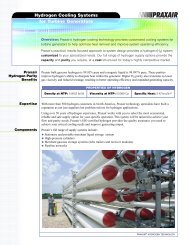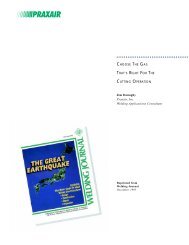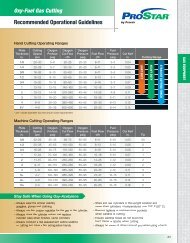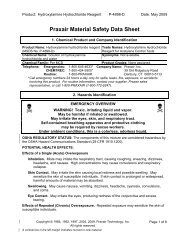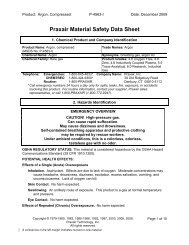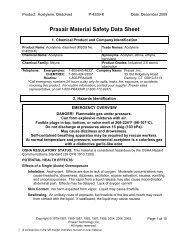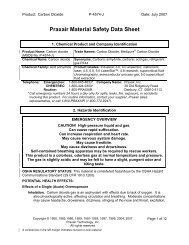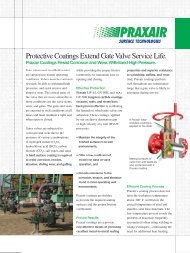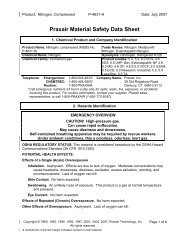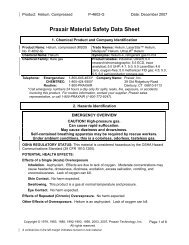You also want an ePaper? Increase the reach of your titles
YUMPU automatically turns print PDFs into web optimized ePapers that Google loves.
properties that it owns or operates and at other properties where <strong>Praxair</strong> or its predecessors have operated or<br />
arranged for the disposal of hazardous wastes. Although management does not believe that any such liabilities<br />
will have a material adverse impact on its financial position and results of operations, management cannot<br />
provide assurance that such costs will not increase in the future or will not become material. See the section<br />
captioned “Management’s Discussion and Analysis – Environmental Matters” in Item 7 of this <strong>10</strong>-K.<br />
Potential tax liabilities could adversely impact the company’s financial position and results of operations.<br />
<strong>Praxair</strong> is subject to income and other taxes in both the United States and numerous foreign jurisdictions.<br />
The determination of the company’s worldwide provision for income taxes and other tax liabilities requires<br />
judgment and is based on diverse legislative and regulatory structures that exist in the various jurisdictions where<br />
the company operates. Although management believes its estimates are reasonable, the ultimate tax outcome may<br />
differ from the amounts recorded in its financial statements and may materially affect the company’s results of<br />
operations for the period when such determination is made. See Note 18 to the consolidated financial statements.<br />
Operational risks may adversely impact the company’s business or results of operations.<br />
<strong>Praxair</strong>’s operating results are dependent on the continued operation of its production facilities and its<br />
ability to meet customer contract requirements and other needs. Insufficient or excess capacity threatens the<br />
company’s ability to generate competitive profit margins and may expose the company to liabilities related to<br />
contract commitments. Operating results are also dependent on the company’s ability to complete new<br />
construction projects on time, on budget and in accordance with performance requirements. Failure to do so may<br />
expose the business to loss of revenue, potential litigation and loss of business reputation.<br />
Also inherent in the management of the company’s production facilities and delivery systems, including<br />
storage, vehicle transportation and pipelines, are operational risks that require continuous training, oversight and<br />
control. Material operating failures at production, storage facilities or pipelines, including fire, toxic release and<br />
explosions, or the occurrence of vehicle transportation accidents could result in loss of life, damage to the<br />
environment, loss of production and/or extensive property damage, all of which may negatively impact the<br />
company’s results of operations, cash flows and reputation.<br />
The inability to effectively integrate acquisitions could adversely impact the company’s financial position and<br />
results of operations.<br />
<strong>Praxair</strong> has evaluated, and expects to continue to evaluate, a wide array of potential strategic transactions.<br />
Many of these transactions, if consummated, could be material to its financial condition and results of operations.<br />
In addition, the process of integrating an acquired company, business or group of assets may create unforeseen<br />
operating difficulties and expenditures. Although historically the company has been successful with its<br />
acquisition strategy and execution, the areas where the company may face risks include:<br />
• The need to implement or remediate controls, procedures and policies appropriate for a larger public<br />
company at companies that prior to the acquisition lacked these controls, procedures and policies;<br />
• Diversion of management time and focus from operating existing business to acquisition integration<br />
challenges;<br />
• Cultural challenges associated with integrating employees from the acquired company into the existing<br />
organization;<br />
• The need to integrate each company’s accounting, management information, human resource and other<br />
administrative systems to permit effective management;<br />
• Difficulty with the assimilation of acquired operations and products;<br />
• Failure to achieve targeted synergies; and<br />
• Inability to retain key employees and business relationships of acquired companies.<br />
<strong>10</strong>



